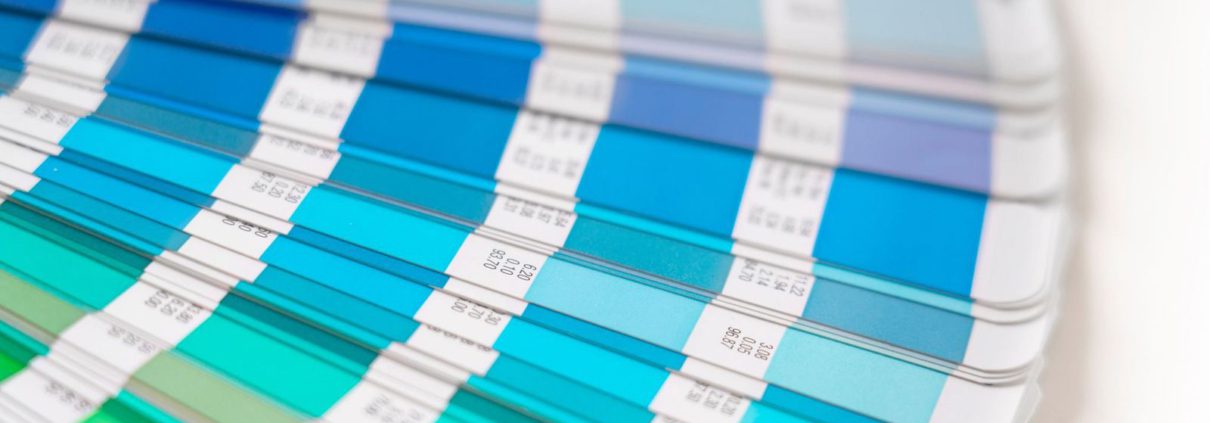How to Choose the Best Classic Colors for Your Brand
Choosing the best classic colors for your brand can be overwhelming, especially if you need help knowing where to start or why classic colors are beneficial.
Why Choose Classic Colors For Your Brand?
Let’s start with the burning question: Why should you choose classic colors for your brand? The short answer is that they not only convey professionalism, trust, and relatability to your ideal audience but also provide a sense of timelessness and endurance.
Brainstorm Your Logo Creation Today!
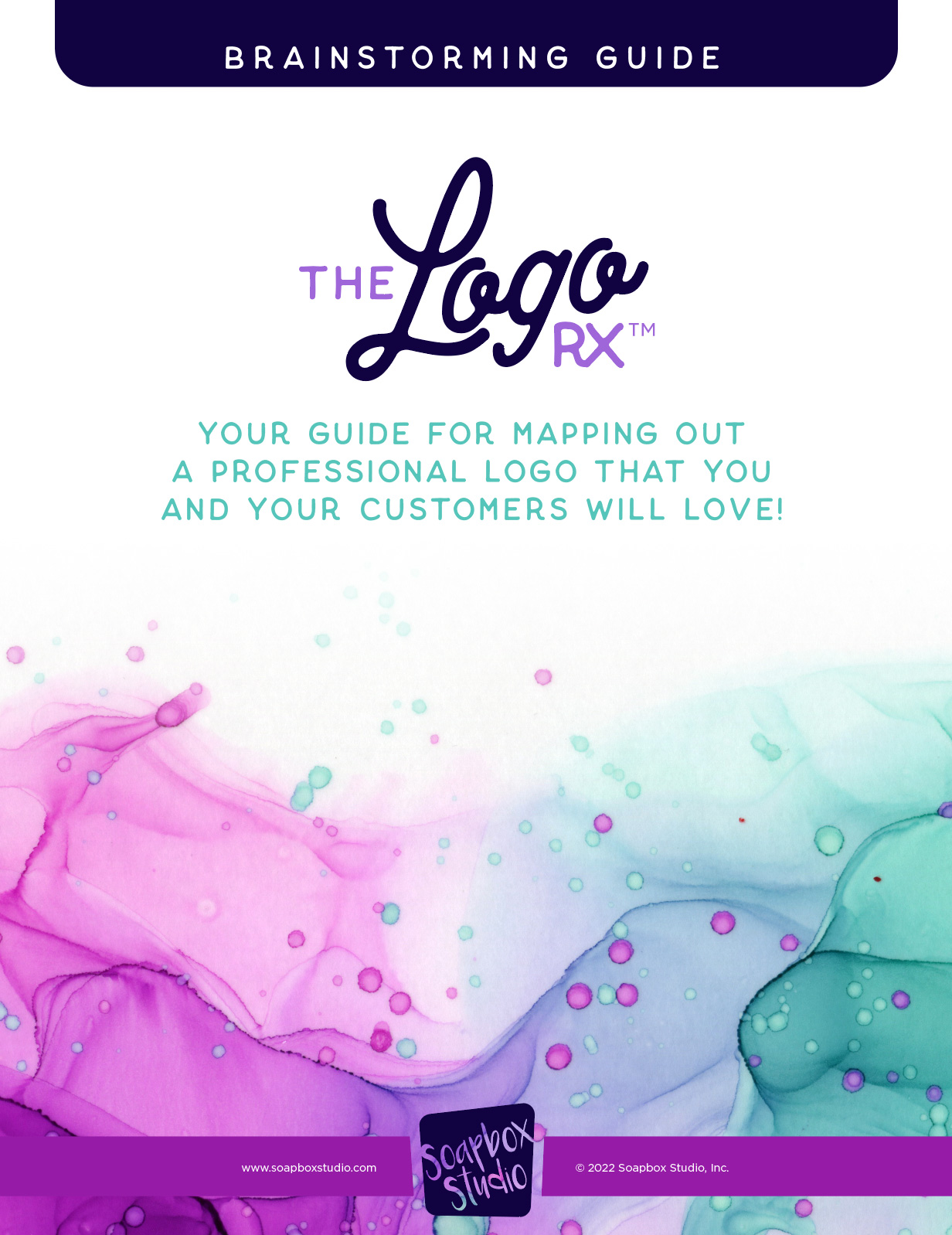
This guide will walk you through the steps I use as a professional designer, to create beautiful logos for all my clients. I am sharing my steps for FREE, so you can use this secret sauce on your own logos.
These timeless hues help establish a solid and consistent brand identity that resonates with a broad range of customers, giving you confidence that your brand will stand the test of time.
If you find choosing a classic color palette challenging, keep reading for five easy steps.
How to Choose Classic Colors For Your Brand
Let’s go over the strategy of choosing classic colors for your brand with these topics:
Possible Pitfalls When Choosing Brand Colors
- Choosing the Wrong Colors For Your Ideal Audience
- Not Having Contrast In Your Palette
- Choosing Too Many Colors
- Choosing Trendy Colors
What is a Classic Color
Examples of Classic Color Palettes
Steps To Choose Classic Colors For Your Brand
- Step 1: Identify Your Business
- Step 2: Understand Your Ideal Customer
- Step 3: Analyze Your Competition
- Step 4: Brainstorm Harmonious Colors
- Step 5: Develop Your Color Palette
Get Started – Choose Your Classic Colors
Possible Pitfalls When Choosing Brand Colors
While choosing brand colors is an exciting and creative process, it’s important to be aware of potential pitfalls to ensure it remains enjoyable and effective. By understanding these common mistakes, you can steer clear of them and make the process smoother and more successful.
Choosing the Wrong Colors for Your Ideal Audience
One of the most crucial aspects of choosing brand colors is to consider the preferences and expectations of your target audience. Colors have the power to evoke emotions and influence perceptions, making it essential to select colors that resonate with your ideal customers. This understanding is key to creating a brand that connects with your audience – you can learn more about this by reading this post: .
The wrong colors can have a major impact on your brand and how your customers perceive your brand identity. Your brand might appear to be a cookie shop when you are really a hair salon. Another example of poor choice of color is using only feminine colors in branding when your business serves everyone—not just women.
Just carefully consider the message your colors convey to ensure they accurately reflect your brand’s identity and appeal to your target audience.
Not Having Contrast in Your Palette
Ensuring that your brand color palette has contrast is a big deal. What does it mean to have contrast in your palette? Contrast simply means not using all the same tones. There is a noticeable difference in brightness, hue, or saturation between different elements in your design.
If the contrast is too low, your potential client will not be able to read it clearly. There are websites like Constrast Checker that can check the contrast of your colors.
You can also use black and white in your color palette, especially on your website, to help alleviate accessibility issues.
Choosing Too Many Colors
While incorporating various colors into your brand can seem exciting and vibrant, it’s crucial to exercise restraint to avoid diluting your brand’s impact. When you use too many colors, your brand identity can become forgettable, which is the opposite of what you want to achieve.

Limiting your color palette to no more than five main colors is a practical guideline to maintain coherence and memorability. This manageable selection ensures your brand remains visually consistent across various platforms and materials. Each color should serve a distinct purpose, whether it’s for primary branding elements, accents, or backgrounds.
If you are drawn to more than five colors you’d like to incorporate, consider using mdigi.tools to refine your classic color palette. This tool allows you to adjust the brightness or darkness of your chosen colors, providing subtle variations that offer contrast while maintaining overall cohesiveness.
By adhering to a concise color palette and utilizing tools to refine your selections, you can create a visually striking brand identity that leaves a lasting impression on your audience. Remember, it’s not about how many colors you use but how effectively you use them to communicate your brand’s message and values.
Choosing Only Trendy Colors
While it can be tempting to hop on the latest color trends, exercising caution and restraint is essential. Relying solely on trendy colors poses a significant risk to your brand identity because these trends are transient and subject to change with each passing season or fad.
Opting for trendy colors may give your brand a contemporary and fashionable appearance in the short term. However, your brand’s visual identity may become outdated and irrelevant as trends evolve. This frequent need for updates can lead to inconsistency and confusion among your audience.
Instead, prioritize selecting colors that transcend fleeting trends and stand the test of time. Your brand colors should evoke a sense of trust, professionalism, and reliability, regardless of the current fashion. Choosing timeless colors establishes a strong foundation for your brand identity that remains relevant and resonant over the long term.
Use trendy colors sparingly as accents or secondary elements, allowing your core colors to anchor your brand identity firmly.
What is a Classic Color?
Classic colors are timeless and enduring, maintaining relevance and appeal across generations and trends. Unlike trendy hues that come and go with changing fashion, classic colors possess a timeless quality that transcends fleeting fads.
Typically, classic colors are foundational shades that evoke a sense of stability, sophistication, and reliability. They are the backbone of your brand’s visual identity, providing a solid base to build your brand image.
Among the most widely recognized classic colors are black, blue, green, red, and gold. These hues have endured and continue to be embraced in various contexts, from fashion and design to branding and marketing.
Examples of Classic Color Palettes
Classic Palette #1 – Fun/Food
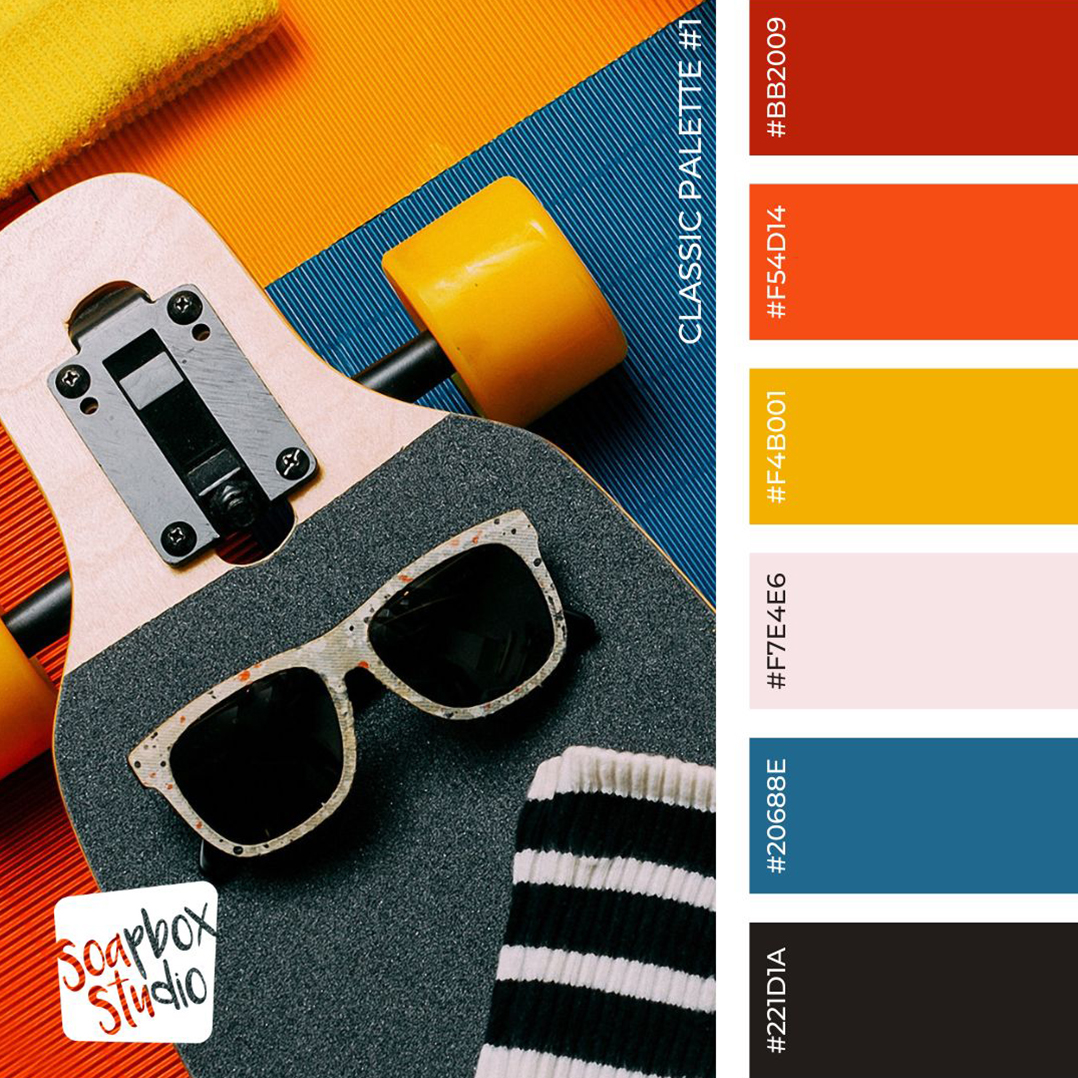
Our first classic color palette expresses a vibrant business, from food and drink to news and information. Taking a look at each individual color you will see different attributes.
#BB2009 – A bold and vibrant shade of red, giving a strong, energetic feel.
#F54D14 – A bright, warm orange that adds a lively and dynamic touch.
#F4B001 – A rich, sunny yellow, which brings a cheerful and optimistic vibe.
#F7E4E6 – A soft, pastel pink that provides a gentle and soothing contrast to the bolder colors.
#20688E – A deep, cool blue that offers a refreshing balance to the warm tones.
#221D1A – A dark, earthy brown, adding depth and grounding to the overall palette.
These colors together create a harmonious and visually appealing combination, perfect for a variety of businesses. The skateboard, sunglasses, and striped socks in the image utilize this palette, illustrating how these colors can be effectively used in practical, classic ways.
Classic Palette #2 – Finance/Business
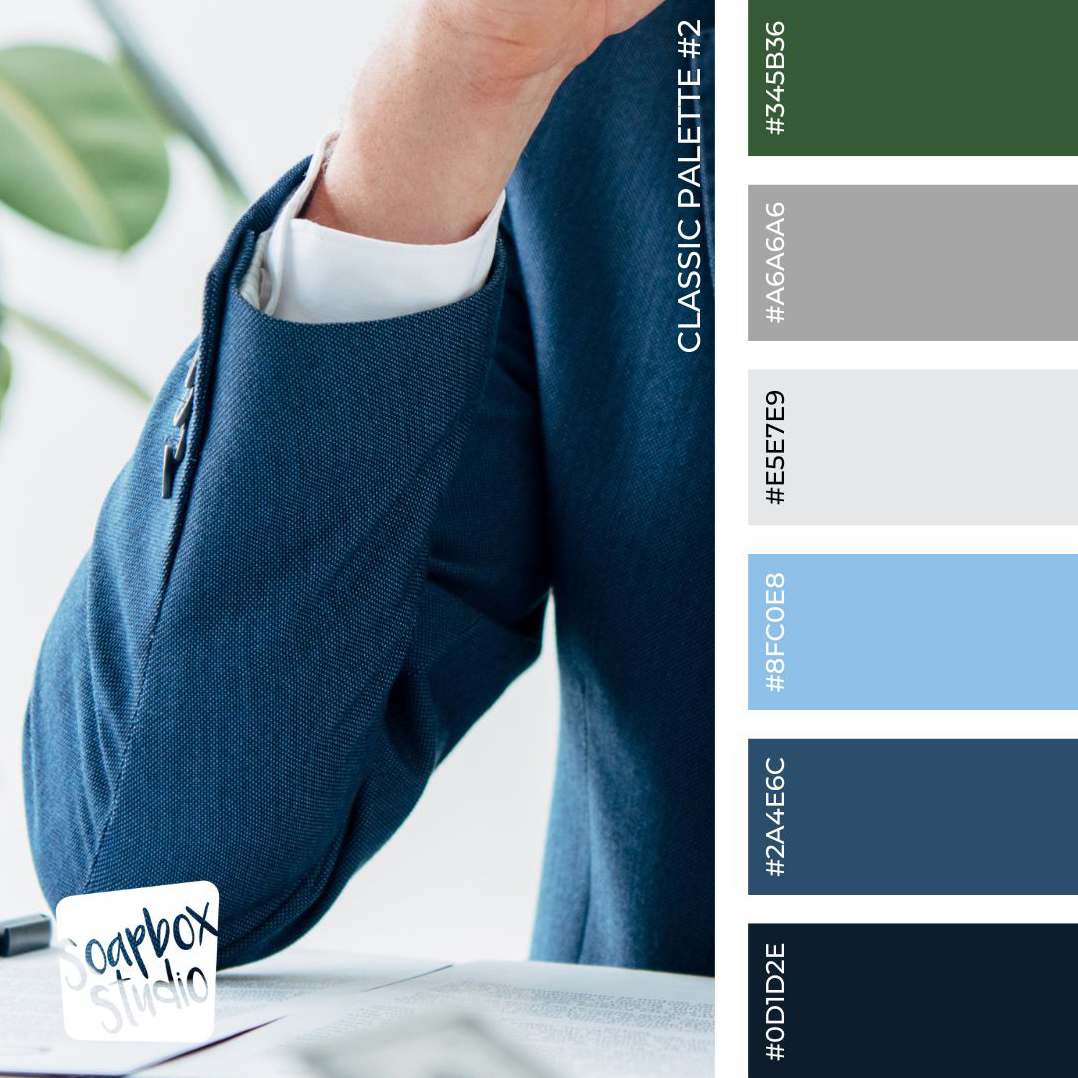
This color palette is perfectly suited for the wealth and finance industry, conveying professionalism, stability, and trust. Let’s look closer at each color.
#345B36 – A deep green that signifies growth, stability, and prosperity.
#A6A6A6 – A neutral gray that adds a sense of balance, calmness, and professionalism.
#E5E7E9 – A very light gray, almost white, which conveys clarity, simplicity, and sophistication.
#8FCOE8 – A soft blue that evokes trust, dependability, and tranquility.
#2A4E6C – A muted blue that suggests strength, reliability, and intelligence.
#0D1D2E – A dark navy blue, giving a sense of authority, confidence, and formality.
These colors together create a refined and elegant palette, ideal for the financial sector. The deep greens and blues project a sense of reliability and trust, essential in the industry, while the grays and light blue add balance and clarity, making this combination visually appealing and highly functional for corporate branding and professional presentations.
The use of such a palette can help instill confidence in clients and stakeholders, reinforcing the stability and credibility of the financial institution.
Classic Palette #3 – Architecture
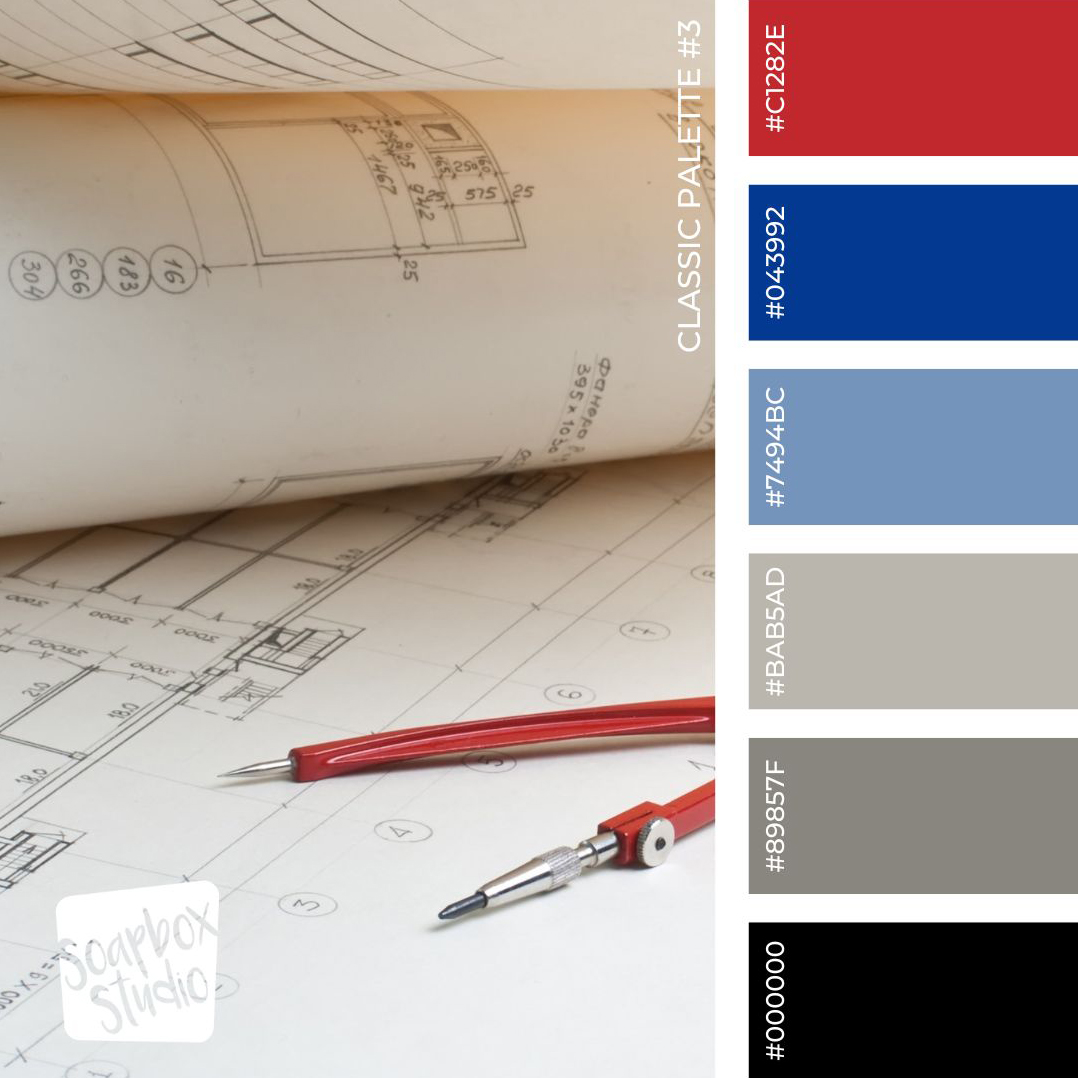
This color palette is ideal for an architecture or business company, reflecting a professional and sophisticated aesthetic. The palette consists of six distinct colors:
#C1282E – A bold red that conveys strength, determination, and professionalism. It can be used for accents to draw attention and highlight important elements.
#04399Z – A deep, rich blue that exudes trust, stability, and intelligence. This color works well as a primary color for backgrounds or large elements.
#7494BC – A soft, muted blue that adds a touch of calmness and reliability. It’s perfect for secondary elements or backgrounds to complement the primary colors.
#BAB5AD – A neutral light gray that brings a sense of balance and neutrality. It serves as a great background or base color to ensure other colors stand out.
#89857F – A darker gray that introduces depth and sophistication. It can be used for text, outlines, or smaller details to provide contrast.
#000000 – A classic black that is essential for sharpness and definition. It’s ideal for text, borders, and any elements that require high visibility and clarity.
These colors together create a cohesive and polished look that is perfect for an architectural or business context. The bold red and rich blue establish a strong visual identity, while the muted blue, light gray, and darker gray offer a balanced and professional backdrop.
The black provides the necessary contrast to ensure readability and clarity, making this palette versatile for both digital and print applications.
Classic Palette #4 – Tech
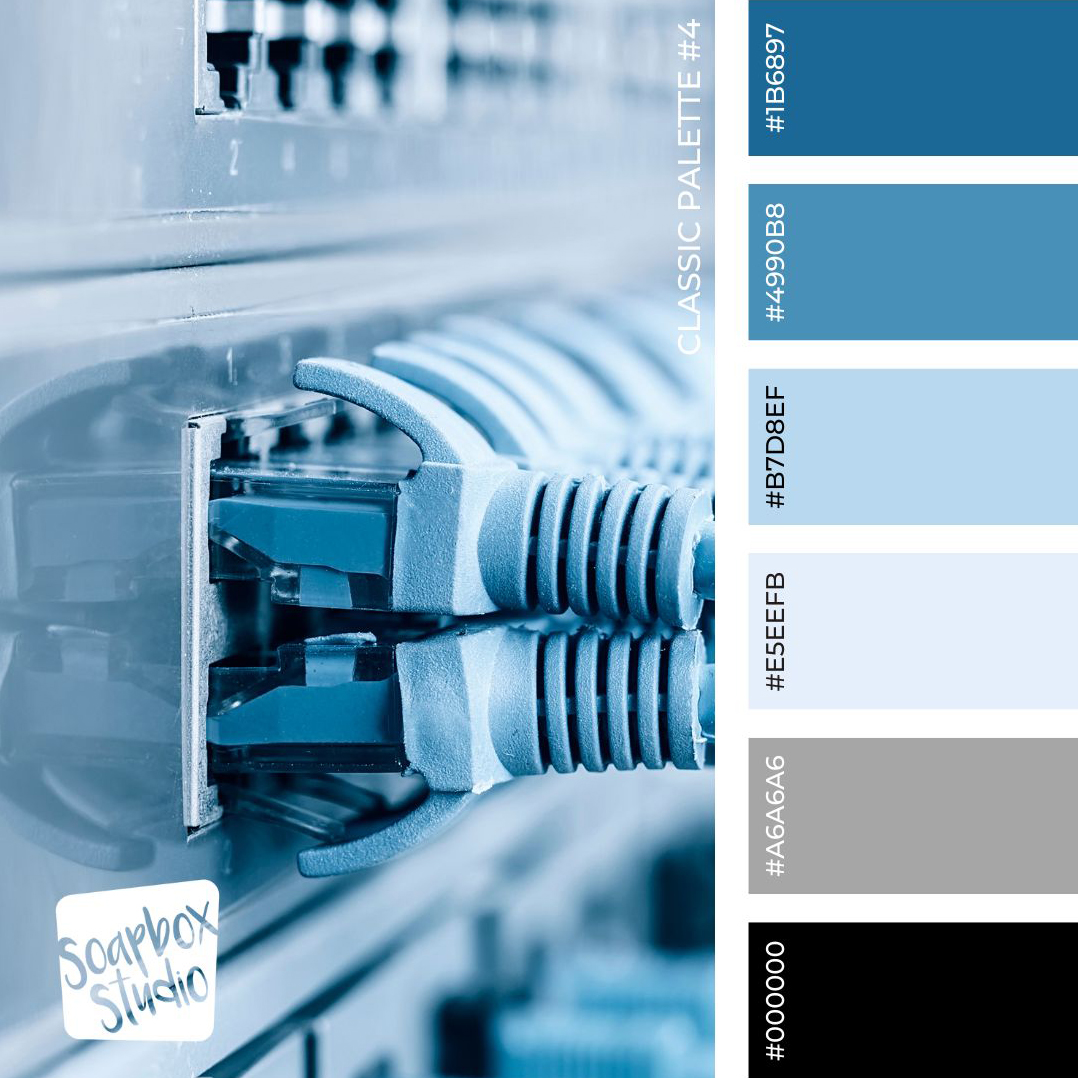
This color palette is ideal for a technology company, reflecting a modern and sleek aesthetic. The palette consists of six distinct colors:
#1B6897 – A deep, vibrant blue that conveys trust, reliability, and professionalism. It can be used for primary elements to create a strong visual presence.
#4990B8 – A medium blue that exudes calmness and stability. It works well for secondary elements and provides a harmonious complement to the deeper blue.
#B7D8EF – A light blue that adds a sense of openness and freshness. It is perfect for backgrounds or large areas to maintain a clean and modern look.
#E5EEFB – An even lighter blue that brings a touch of softness and neutrality. It can be used for backgrounds or accents to create a sense of space and clarity.
#A6A6A6 – A neutral gray that adds balance and sophistication. This color is ideal for text, borders, or other elements where subtle contrast is needed.
#000000 – A classic black that ensures sharpness and definition. It’s essential for text, icons, and any elements requiring high visibility and clarity.
These colors together create a cohesive and contemporary look that is perfect for a technology context. The deep and medium blues establish a trustworthy and professional identity, while the light and very light blues provide a clean and modern backdrop.
The neutral gray offers balance and sophistication, and the black ensures high visibility and sharpness. This palette is versatile for both digital interfaces and print materials, making it ideal for a technology company’s branding and communication needs.
Classic Palette #5 – Natural Living
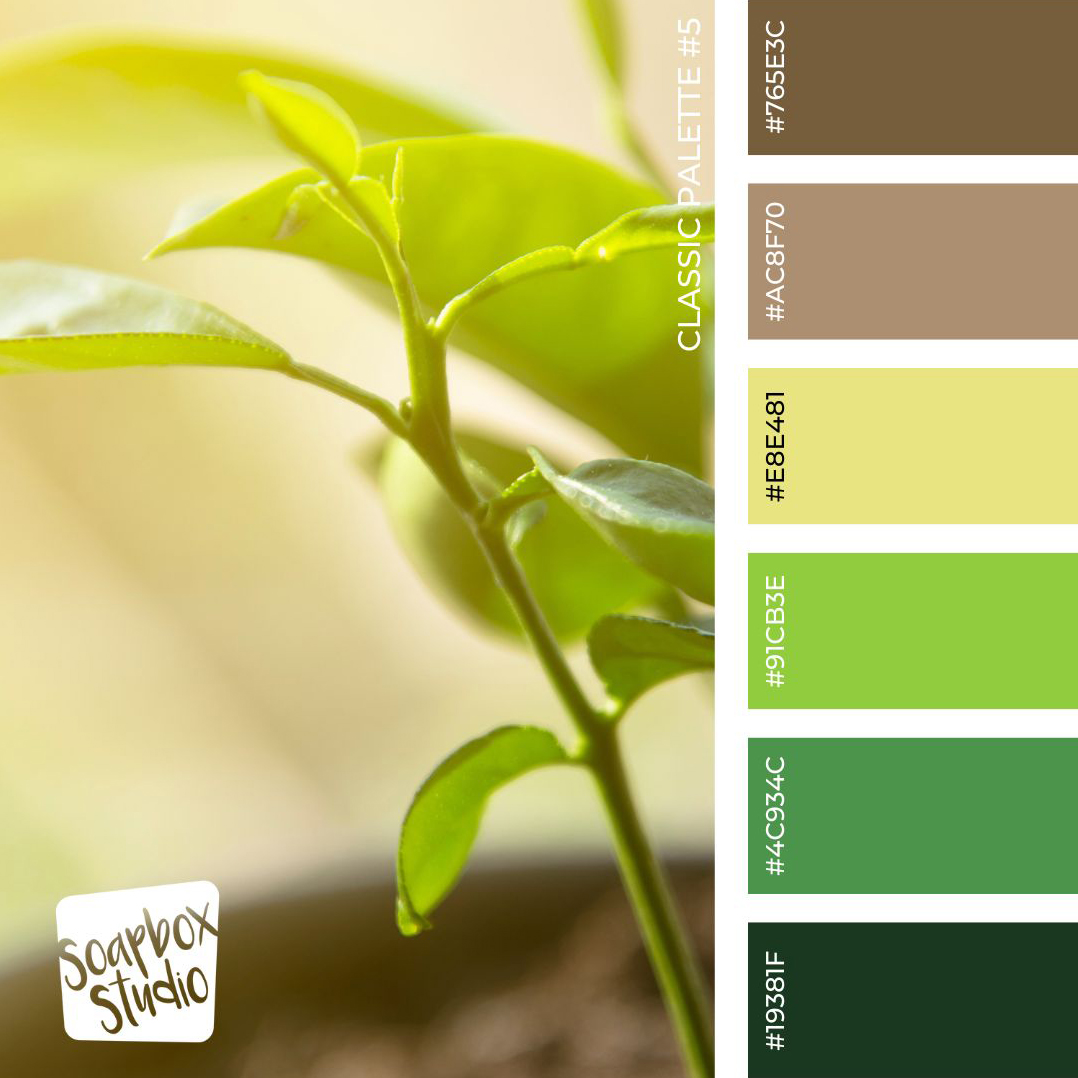
This color palette is ideal for a health and wellness, homesteading, or natural food company, reflecting a vibrant and earthy aesthetic. The palette consists of six distinct colors:
#765E3C – A rich brown that conveys stability, reliability, and a connection to the earth. It can be used for primary elements to ground the design and add warmth.
#AC8F70 – A soft, muted beige that exudes calmness and approachability. This color works well for secondary elements, providing a harmonious and natural feel.
#EBE481 – A light, pastel yellow that adds a touch of freshness and energy. It is perfect for accents or backgrounds to create a bright and welcoming atmosphere.
#91CB3E – A vibrant lime green that symbolizes growth, health, and vitality. This color is great for highlighting important elements and adding a pop of color.
#4C934C – A medium green that introduces balance and harmony. It can be used for larger areas or backgrounds to maintain a natural and soothing look.
#19381F – A deep, forest green that ensures depth and sophistication. It’s ideal for text, borders, or elements requiring high contrast and readability.
These colors together create a cohesive and refreshing look that is perfect for a health and wellness, homesteading, or natural food context. The rich brown and muted beige establish a grounded and approachable foundation, while the pastel yellow and lime green inject energy and vitality.
The medium green offers balance and harmony, and the deep forest green ensures readability and sharpness. This palette is versatile for both digital interfaces and print materials, making it ideal for branding and communication needs in the health and wellness, homesteading, or natural food industries.
Steps to Choose Classic Colors For Your Brand
The steps to choose the best classic colors for your brand are not only effective but also easy and straightforward, providing you with a reassuring guide through the process.
Step 1: Identify Your Business
Start by empowering yourself with a clear understanding of your business. Spend a little time making a list of what your company does. This foundational step is crucial because understanding your business’s core activities, values, and mission will guide all your subsequent branding decisions, including color choices.
Clearly defining your business helps ensure that every element of your brand, including colors, aligns with and reinforces your brand identity, giving you the power to shape your brand’s perception.
After you have a clear understanding of your business, think about the colors that are already associated with your brand. Evaluate these existing colors and consider incorporating them into your new palette instead of fighting them.
Additionally, color theory should be researched to understand better how different colors interact and the emotions they evoke. For more in-depth guidance on color theory, read this comprehensive post: Finding the Right Colors for Your Brand.
Step 2: Understand Your Ideal Customer
To effectively choose the best classic brand colors, it’s crucial to understand your ideal customer. Start by considering color preferences from the perspective of your target audience, not just your personal favorites. This ensures that your color choices resonate with your clients and don’t inadvertently repel them.
Choose colors that align with your product and industry to help your customers easily understand your brand. For instance, green might be ideal for a business in the food industry focused on salads, while pastel colors would be fitting for a company making custom baby blankets.
Additionally, consider the cultural and emotional impacts of your color choices, as different colors can evoke various meanings and associations in different cultures.
Testing your color palette and gathering feedback from a sample of your target audience can provide valuable insights into how your colors are perceived. By aligning your color choices with your audience’s preferences and the nature of your product, you can create a color palette that enhances brand recognition and appeal.
Step 3: Analyze Your Competition
Researching your competition’s colors is essential for developing your brand’s color palette. Start by identifying your main competitors and analyzing their branding to note the primary and secondary colors they use across various platforms. This analysis will help you identify industry trends and understand which colors are commonly associated with specific messages or emotions in your industry.
Recognizing these trends can guide you in selecting colors that convey the desired attributes of professionalism, trust, or innovation relevant to your brand.
While understanding industry standards is essential, differentiating your brand is equally crucial. Look for opportunities to stand out by choosing unique color combinations or shades that set your brand apart.
Step 4: Brainstorm Harmonious Colors
When brainstorming harmonious colors for your brand, first, let’s briefly examine what colors mean. Each color evokes different emotions and associations, significantly impacting how your brand is perceived.
For example, blue often conveys trust, professionalism, and calmness, making it a popular choice for corporate and tech brands. Red is associated with energy, passion, and urgency, which can be effective for brands looking to evoke excitement or stimulate action.
Green symbolizes health, tranquility, and nature, making it ideal for eco-friendly and wellness brands. Yellow represents happiness, optimism, and warmth, which can be great for brands aiming to appear friendly and approachable. Understanding these basic color meanings can help you craft a color palette that aligns with your brand’s core values and message.
However, to create a truly effective color palette, it’s crucial to research color meanings and how they specifically relate to your brand and industry.
Spend more time studying color theory, including how different colors interact and their psychological effects on your target audience. You can learn more about the psychology of color by reading this post: Drawing in Clients: A Complete Guide to Creating an Irresistible Brand Color Palette.
Step 5: Develop Your Color Palette
Developing your color palette is crucial in solidifying your brand’s visual identity. Experiment with color options using online tools like Developing your color palette is crucial in solidifying your brand’s visual identity. Experiment with color options using online tools like https://mdigi.tools/lighten-color. This tool allow you to adjust shades, create harmonious combinations, and visualize how different colors interact. They are invaluable for refining your choices and ensuring that the colors you select complement each other well.
If you find the process overwhelming or want a professional touch, consider hiring a designer or branding expert. Professional help can provide insights and expertise that ensure your color palette is visually appealing and strategically aligned with your brand’s identity and goals.
Soapbox designers can help interpret color theory and industry standards to craft a palette that stands out while resonating with your target audience – get in touch with us here.
Get Started – Choose Your Classic Colors
Now, it’s time to start choosing the best classic colors for your brand! To start creating your palette, choose your first classic color. This foundational step sets the tone for the rest of your color scheme. Your first color should embody your brand’s core values and personality. Once selected, use a color-picking tool to explore complementary and harmonious shades.
Remember the meanings and psychological impacts of colors and what works best for your industry. Based on this initial choice, add your second color. Continue this process, adding up to two or three more colors, until you’ve created a cohesive and balanced color scheme that you love and effectively represents your brand. You can ensure a solid and memorable visual identity by methodically developing your color palette with these tools and strategies.

